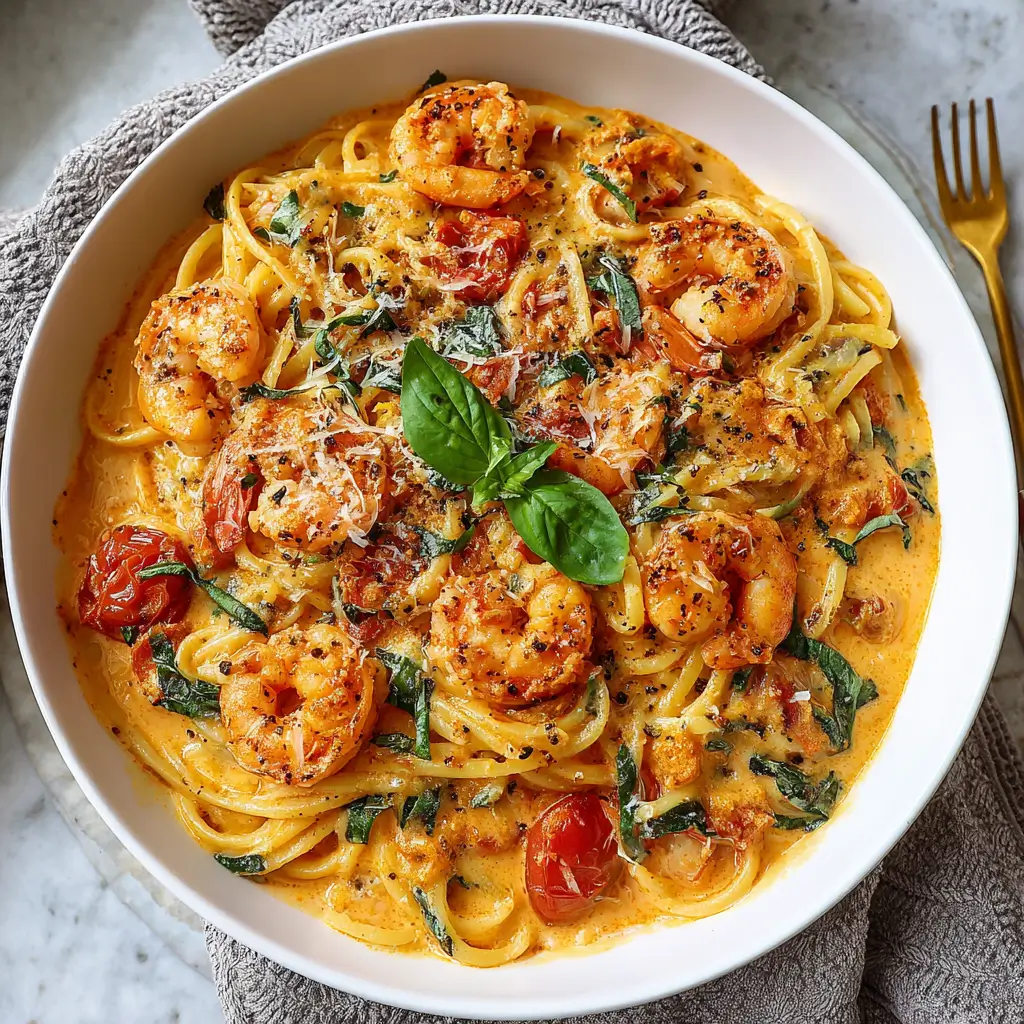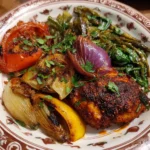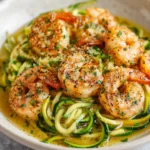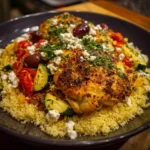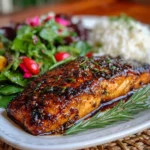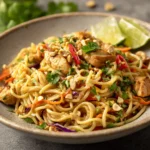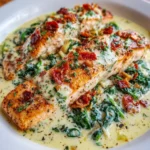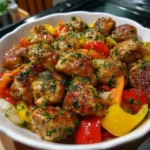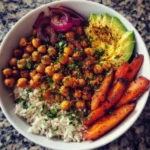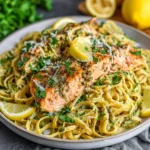Creamy Tomato Basil Shrimp Pasta: A Rich and Flavorful Delight
Indulge in the luscious blend of tender shrimp, al dente pasta, vibrant tomatoes, fresh basil, and a velvety creamy tomato sauce with this exquisite Creamy Tomato Basil Shrimp Pasta. This dish strikes the perfect balance between rustic Italian flavors and modern comfort food, making it ideal for weeknight dinners or impressing guests at a dinner party. With its rich red-orange hue, aromatic fragrance, and satisfying texture, every bite is a celebration of freshness and flavor.
The History of Creamy Tomato Basil Shrimp Pasta
While classic Italian pasta dishes like spaghetti alle vongole (clams) and penne al pomodoro have long celebrated seafood and tomatoes, the concept of combining shrimp with a creamy tomato-based sauce is a more modern fusion. Originating in late 20th-century Italian-American cuisine, this dish reflects the creative blending of traditional Mediterranean ingredients with American preferences for creamy textures and bold flavors.
Tomatoes, once considered suspicious in Europe, were eventually embraced in Italy by the 18th century, becoming central to regional cuisines. Basil, a staple in Genovese pesto and Neapolitan sauces, complements tomatoes perfectly due to their shared volatile compounds that enhance each other’s aroma. Shrimp, commonly used in coastal regions like Sicily and Campania, bring a delicate sweetness to pastas. The addition of cream—less common in authentic Italian cooking but popularized abroad—adds silkiness and richness, transforming simple aglio e olio or marinara into a luxurious entrée.
Creamy Tomato Basil Shrimp Pasta has since become a favorite on restaurant menus across North America and beyond, symbolizing the evolution of global pasta culture where tradition meets innovation.
Ingredients Breakdown: What Makes This Dish Shine
The magic of this recipe lies in its carefully selected ingredients, each playing a crucial role in building layers of flavor, texture, and aroma:
- Fresh Shrimp: Large or jumbo shrimp, peeled and deveined, provide a succulent, slightly sweet protein that cooks quickly and absorbs surrounding flavors beautifully.
- Pasta: Linguine or fettuccine are ideal for holding creamy sauces, though penne or rigatoni work well too. Whole wheat or gluten-free alternatives can be used for dietary needs.
- Tomatoes: Canned crushed tomatoes offer consistent depth and acidity, while fresh cherry tomatoes can be added for brightness and pop.
- Heavy Cream: Adds luxurious mouthfeel and mellows the acidity of the tomatoes. Coconut cream can substitute for a dairy-free version.
- Garlic & Shallots: Form the aromatic base, sautéed to golden perfection without burning, releasing savory-sweet notes.
- Fresh Basil: Essential for that signature herbal lift; added both during cooking and as a garnish for maximum fragrance.
- Olive Oil & Butter: Olive oil ensures a clean, fruity foundation, while butter enriches the sauce with a silky finish.
- White Wine: Deglazes the pan and introduces subtle complexity, enhancing umami and balancing richness.
- Seasonings: Red pepper flakes add gentle heat, salt and black pepper adjust seasoning, and a touch of sugar balances tomato tartness.
- Grated Parmesan: Optional but recommended—it adds nuttiness and helps thicken the sauce slightly.
Step-by-Step Recipe: How to Make Creamy Tomato Basil Shrimp Pasta
- Prepare Ingredients: Start by peeling and deveining the shrimp, patting them dry with paper towels. Mince 4 cloves of garlic, finely dice 1 small shallot, chop 1 cup of fresh basil (reserving some leaves for garnish), and measure out all other ingredients. Use high-quality canned crushed tomatoes (preferably San Marzano) for best results.
- Cook the Pasta: Bring a large pot of salted water to a boil (use about 1 tablespoon of salt per quart). Add 12 ounces of linguine and cook until al dente—usually 8–10 minutes depending on brand. Reserve 1 cup of starchy pasta water before draining. Do not rinse the pasta; the starch helps the sauce cling better.
- Sear the Shrimp: While the pasta cooks, heat 1 tablespoon of olive oil in a large skillet over medium-high heat. Season shrimp with salt, pepper, and a pinch of red pepper flakes. Sear for 1–2 minutes per side until pink and just opaque. Remove and set aside—do not overcook, as they will return to the sauce later.
- Sauté Aromatics: In the same pan, reduce heat to medium. Add 1 tablespoon butter and 1 tablespoon olive oil. Add diced shallot and sauté for 2–3 minutes until translucent. Stir in minced garlic and cook for 30 seconds until fragrant—be careful not to burn.
- Build the Sauce: Pour in ½ cup dry white wine (such as Pinot Grigio or Sauvignon Blanc) to deglaze the pan, scraping up any browned bits. Let simmer for 2 minutes until reduced by half. Add 2 cups of crushed tomatoes, 1 teaspoon dried oregano, ½ teaspoon red pepper flakes (adjust to taste), and a pinch of sugar. Simmer uncovered for 8–10 minutes, allowing the sauce to thicken slightly.
- Add Cream & Cheese: Stir in ¾ cup heavy cream and simmer gently for another 3–4 minutes. Do not boil vigorously, as the cream may separate. Optionally, stir in ¼ cup grated Parmesan cheese until melted and smooth.
- Combine Everything: Return the seared shrimp to the skillet. Add the drained pasta and toss thoroughly to coat. If needed, add reserved pasta water a few tablespoons at a time to loosen the sauce and create an emulsified texture.
- Finish with Fresh Basil: Remove from heat and stir in most of the chopped fresh basil. Taste and adjust seasoning with salt, pepper, or a splash of lemon juice if desired.
- Serve Immediately: Divide among warmed bowls. Garnish with extra basil leaves, a drizzle of olive oil, freshly cracked black pepper, and additional Parmesan if desired.
Tips for Perfect Creamy Tomato Basil Shrimp Pasta Every Time
- Don’t Overcook the Shrimp: Shrimp cook very fast—overcooking makes them rubbery. Remove them from the pan as soon as they turn pink and opaque.
- Use Room-Temperature Cream: Cold cream added to a hot pan may curdle. Let it sit out for 10–15 minutes before using.
- Reserve Pasta Water: The starchy liquid is gold! It helps bind the sauce to the pasta and improves texture dramatically.
- Bloom the Garlic: Cook garlic briefly—just until fragrant—to avoid bitterness. Burnt garlic ruins the flavor profile.
- Simmer, Don’t Boil the Sauce: Gentle simmering preserves the integrity of the cream and allows flavors to meld without splitting.
- Season in Layers: Season shrimp, sauce, and final dish separately. This builds depth rather than relying on one seasoning step.
- Prep Ahead: Chop vegetables, measure spices, and have everything ready before starting—this dish comes together quickly.
- Warm Your Plates: Serving on warm plates keeps the pasta hotter longer and enhances enjoyment.
Variations and Customizations
This versatile recipe welcomes creativity. Here are some delicious twists:
- Protein Swaps: Replace shrimp with grilled chicken, scallops, crab meat, or even plant-based shrimp for a vegan option.
- Dairy-Free Version: Substitute heavy cream with full-fat coconut milk and omit Parmesan or use nutritional yeast for cheesy flavor.
- Gluten-Free Option: Use your favorite GF pasta—rice, chickpea, or corn-based—and ensure all other ingredients are certified gluten-free.
- Veggie Boost: Add spinach, sun-dried tomatoes, roasted red peppers, artichoke hearts, or zucchini ribbons during the last few minutes of cooking.
- Spicier Kick: Increase red pepper flakes or add a dash of cayenne or Calabrian chili paste for intense heat.
- Lemon Zest Twist: Brighten the dish with grated lemon zest or a squeeze of fresh lemon juice before serving.
- Herb Variations: Try adding parsley, oregano, or thyme alongside or instead of basil for different herbal nuances.
- Seafood Medley: Combine shrimp with mussels, clams, or calamari for a surf-and-turf-style pasta.
- Creamy Pesto Fusion: Swirl in 1–2 tablespoons of basil pesto at the end for an extra layer of herbaceous richness.
- Baked Version: Transfer the finished pasta to an oven-safe dish, top with mozzarella, and broil for 3–5 minutes for a bubbly gratin effect.
Health Considerations and Nutritional Value
Creamy Tomato Basil Shrimp Pasta can be part of a balanced diet when enjoyed in moderation. Here’s a breakdown of its nutritional components (per serving, based on 4 servings):
- Calories: ~550–650 kcal (varies with cream amount and pasta type)
- Protein: ~25–30g (from shrimp and dairy)
- Fat: ~20–25g (mostly unsaturated from olive oil, saturated from cream and butter)
- Carbohydrates: ~60–70g (primarily from pasta; lower with whole grain or legume-based options)
- Fiber: ~4–6g (higher with whole wheat pasta and added vegetables)
- Sodium: ~600–900mg (manageable by reducing added salt and choosing low-sodium tomatoes)
Key Health Benefits:
- Shrimp: Low in calories, high in protein, and rich in selenium, iodine, and omega-3 fatty acids (especially EPA and DHA), which support heart and brain health.
- Tomatoes: Excellent source of lycopene, a powerful antioxidant linked to reduced risk of certain cancers and cardiovascular disease. Cooking enhances lycopene absorption.
- Olive Oil: Heart-healthy monounsaturated fats and anti-inflammatory polyphenols.
- Basil: Contains antioxidants like eugenol and has antimicrobial and anti-inflammatory properties.
- Garlic: Known for immune-boosting and cholesterol-lowering effects.
Considerations:
- The dish is relatively high in saturated fat due to cream and butter. To lighten it, replace half the cream with evaporated milk or Greek yogurt (add off-heat to prevent curdling).
- For lower-carb diets, serve over spiralized zucchini noodles (zoodles) or spaghetti squash.
- Those with shellfish allergies should avoid shrimp; consider mushrooms or tofu as substitutes.
- Limit portion sizes to maintain caloric balance, especially if following weight management goals.
Full Ingredient List
- 12 oz (340g) linguine or fettuccine
- 1 lb (450g) large shrimp, peeled and deveined
- 2 tbsp olive oil (divided)
- 1 tbsp unsalted butter
- 1 small shallot, finely diced
- 4 cloves garlic, minced
- ½ cup dry white wine (e.g., Pinot Grigio)
- 2 cups crushed tomatoes (preferably San Marzano)
- ¾ cup heavy cream
- ¼ cup grated Parmesan cheese (optional)
- 1 cup fresh basil, chopped (plus extra for garnish)
- 1 tsp dried oregano
- ½–1 tsp red pepper flakes (to taste)
- 1 tsp sugar (optional, to balance acidity)
- Salt and freshly ground black pepper, to taste
- Reserved pasta water, as needed
Detailed Directions
- Fill a large pot with water, add 1 tablespoon of salt, and bring to a rolling boil. Add pasta and cook according to package instructions until al dente. Before draining, reserve 1 cup of the starchy cooking water. Drain pasta and set aside.
- Pat shrimp dry with paper towels. Season lightly with salt, pepper, and a pinch of red pepper flakes.
- Heat 1 tablespoon of olive oil in a large skillet or Dutch oven over medium-high heat. Add shrimp in a single layer and cook for 1–2 minutes per side until pink and opaque. Transfer to a plate and set aside.
- Reduce heat to medium. Add remaining 1 tablespoon olive oil and 1 tablespoon butter to the same pan. Once butter melts, add diced shallot and cook for 2–3 minutes until soft and translucent.
- Add minced garlic and cook for 30 seconds, stirring constantly to prevent burning.
- Pour in white wine to deglaze the pan, scraping up any flavorful browned bits. Simmer for 2 minutes until alcohol evaporates and liquid reduces by half.
- Stir in crushed tomatoes, dried oregano, red pepper flakes, and sugar. Bring to a gentle simmer and cook for 8–10 minutes, stirring occasionally, until sauce thickens slightly.
- Reduce heat to low. Stir in heavy cream and simmer gently for 3–4 minutes. Do not boil. If using, stir in Parmesan cheese until fully melted and incorporated.
- Return cooked shrimp to the skillet. Add drained pasta and toss well to coat. Gradually add reserved pasta water (start with ¼ cup) until sauce reaches a silky, cohesive consistency.
- Remove from heat. Stir in most of the chopped fresh basil. Taste and adjust seasoning with salt, pepper, or a squeeze of lemon juice for brightness.
- Serve immediately in warm bowls. Garnish with remaining basil, a sprinkle of Parmesan, cracked black pepper, and a drizzle of high-quality olive oil if desired.
Frequently Asked Questions (FAQ)
Can I make this ahead of time?
Yes, you can prep components in advance: cook the sauce (without cream), peel shrimp, and measure ingredients. However, assemble and finish the dish just before serving for best texture. Reheating may cause the cream to separate or shrimp to toughen.
How do I store leftovers?
Store in an airtight container in the refrigerator for up to 3 days. Reheat gently on the stove with a splash of water or broth to revive the sauce. Avoid microwaving at high power to prevent overcooking the shrimp.
Can I freeze Creamy Tomato Basil Shrimp Pasta?
Freezing is not recommended due to the dairy content—cream may separate upon thawing, resulting in a grainy texture. Freeze the tomato sauce base (without cream or shrimp) for up to 3 months, then add fresh shrimp and cream when reheating.
Why did my sauce curdle?
Dairy can curdle if exposed to high heat or acidic ingredients. Always add cream at low heat and avoid boiling. Using room-temperature cream helps prevent shock-induced separation.
Is this dish spicy?
It has mild heat from red pepper flakes, but you control the level. Omit entirely for a kid-friendly version or increase for more fire.
Can I use frozen shrimp?
Yes, but thaw them properly in the refrigerator overnight. Pat dry before cooking to ensure proper searing and avoid excess moisture.
What wine should I use?
Choose a dry, crisp white wine you’d enjoy drinking—Pinot Grigio, Sauv Blanc, or Vermentino work well. Avoid “cooking wine” as it contains added salt and preservatives.
Can I make it vegetarian?
Absolutely! Skip the shrimp and boost flavor with sautéed mushrooms, artichokes, or white beans. Use vegetable broth instead of wine if needed.
Summary
Creamy Tomato Basil Shrimp Pasta combines juicy shrimp, al dente noodles, and a luxuriously smooth tomato-cream sauce elevated with fresh herbs and aromatic seasonings. It’s a restaurant-worthy dish that’s surprisingly simple to make at home, perfect for cozy nights or elegant meals alike.
